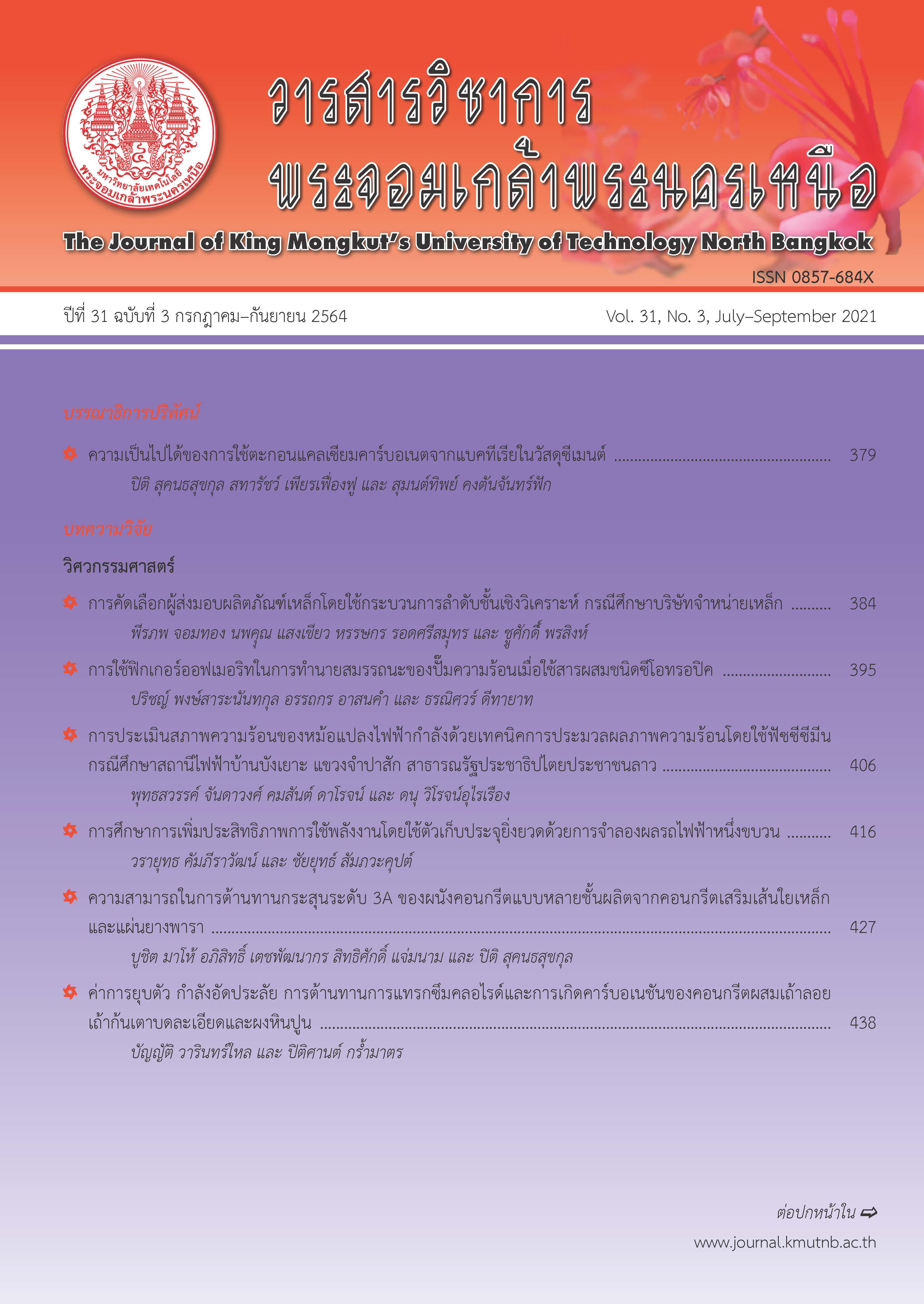Designing a Simple Experimental Kit for Absorbance Measurement in Teaching Chemistry: Determining Sugar Content in Beverages
Main Article Content
Abstract
Lego?, which is a popular toy for all ages has been used as the main material to construct an absorbance measurement kit. The design concept is that the experimental kit was made with materials that are easy to find. Its internal components were simplified to help students clearly understand the concept of the absorbance. Students can build the experimental kit on their own. The designed chemical experiment instrument, utilized as an instructional material, actively promotes learning through its orientation to real-world contexts, predominantly on the topics of spectroscopic methods and the Beer-lambert law. The performance of the experimental kit was tested by measuring the absorbance to investigate the concentration of 3 solutions, which had been prepared in the laboratory. The experimental kit was then applied in a real context to determine sugar content in beverages. The results show the consistency of sugar content in beverages measured by the experimental kit and the one identified on nutrition labels. The relative errors are in the range of ?5% while relative standard deviations is less than 5%. This confirms the accuracy and precision of the experimental kit, indicating its effective performance.
Article Details
The articles published are the opinion of the author only. The author is responsible for any legal consequences. That may arise from that article.
References
[2] S. Pradub, T. Teptit, and V. Vailikhit, “Smart phone photometry for undergraduate chemistry courses,” Journal of Education Naresuan University, vol. 20, no. 2, pp. 233–240, 2018.
[3] Z. Liu, Y. Zhang, S. Xu, H. Zhang, Y. Tan, C. Ma, R. Song, L. Jiang, and C. Yi, “A 3D printed smartphone optosensing platform for point-of-need food safety inspection,” Analytica Chimica Acta, vol. 966, pp. 81–89, 2017.
[4] J. Asheim, E. V. Kvittingen, L. Kvittingen, and R. Verley, “A simple, small-scale lego colorimeter with a light-emitting diode (led) used as detector,” Journal of Chemical Education, vol. 91, no. 7, pp. 1037–1039, 2014.
[5] P. Hu, Y. Chen, and S. Sonkusale, “Low cost spectrometer accessory for cell phone based optical sensor,” in 2015 IEEE Virtual Conference on Applications of Commercial Sensors (VCACS), Raleigh., NC, 2015, pp. 1–5.
[6] S. J. Tavener and J. E. Thomas-Oates, “Build your own spectrophotometer,” Education in Chemistry, vol. 44, pp. 151–154, 2007.
[7] D. R. Albert, M. A. Todt, and H. F. Davis, “A low-cost quantitative absorption spectrophotometer,” Journal of Chemical Education, vol.89, no.11, pp.1432–1435, 2012.
[8] R. McClain, “Construction of a photometer as an instructional tool for electronics and instrumentation,” Journal of Chemical Education, vol. 91, no. 5, pp. 747–750, 2014.
[9] J. R. Vanderveen, B. Martin, and K. J. Ooms, “Developing tools for undergraduate spectroscopy: An inexpensive visible light spectrometer,” Journal of Chemical Education, vol. 90, no. 7, pp. 894–899, 2013.
[10] S. Tuntirojanawong. (2017, May). A direction of educational management in the 21st century. Veridian E-Journal. [Online] (in Thai). 10(2), pp. 2843–2854. Available: https://he02.tcithaijo.org/index.php/Veridian-E-Journal/article/view/109763/86192
[11] N. Tungkananuruk and K. Tungkananuruk, Analytical spectroscopy. Bangkok: Kasetsart University Press, 2004 (in Thai).
[12] D. F. da Silva and D. Acosta-Avalos, “Light dependent resistance as a sensor in spectroscopy setups using pulsed 21st century light and compared with electret microphones,” Sensors (Basel), vol. 6, no. 5, pp. 514–525, 2006.
[13] P. Supawan, Regression Analysis. Bangkok: Phranakhon Rajabhat University Press, 2013 (in Thai).
[14] PerkinElmer. (2017, May). Application note: determination of sugar as glucose in a soft drink using the LAMBDA PDA UV/Vis spectrophotometer. PerkinElmer, Inc., USA. [Online]. Available: https://www.perkinelmer.com/lab-solutions/resources/docs/APP-Determination-of-Sugar-as-Glucose-in-Soft-Drink-using-LAMBDA-465-012356A_01.pdf
[15] M.-C. Wu, M.-P. Lin, S.-W. Chen, P.-H. Lee, J.-H. Li, and W. Su, “Surface-enhanced Raman scattering substrate based on a Ag coated monolayer array of SiO2 spheres for organic dye detection,” RSC Advances, vol. 4, no. 20, pp.10043–10050, 2014.
[16] K. Knagge and D. Raftery, “Construction and evaluation of a LEGO spectrophotometer for student use,” The Chemical Educator, vol. 7, pp. 371–375, 2002.
[17] P. Palachai and S. Muncharoen, “A simple experiment to evaluate the equilibrium constant of bromothymol blue using smart phone for high school students,” SWU Science Journal, vol.22, no. 2, pp.1–14, 2017 (in Thai).
[18] L. Kaijanen, M. Paakkunainen, S. Pietarinen, E. Jernström, and S. Reinikainen, “Ultraviolet detection of monosaccharides: Multiple wavelength strategy to evaluate results after capillary zone electrophoretic separation,” International Journal of Electrochemical Science, vol. 10, no. 4, pp. 2950–2961, 2015.
[19] G. L. Miller, “Use of dinitrosalicylic acid reagent for determination of reducing sugar,” Analytical Chemistry, vol. 31, no. 3, pp. 426–428, 1959.
[20] K. Miloski, K. Wallace, A. Fenger, E. Schneider, and K. Bendinskas, “Comparison of biochemical and chemical digestion and detection methods for carbohydrates,” American Journal of Undergraduate Research, vol. 7, no. 2, pp. 7–18, 2008.
[21] N. Moonrungsee, C. Prachain, C. Bumrungkij, N. Peamaroon, and J. Jakmunee, “A simple device with a smartphone camera for determination of salicylic acid in foods, drugs and cosmetics,” Journal of King Mongkut's Institute of Technology North Bangkok, vol. 28, No. 3, pp. 639–648, 2018 (in Thai).

